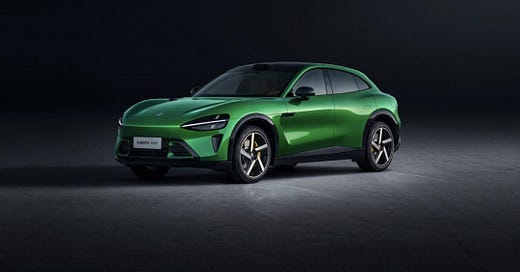Xiaomi’s Rapid EV Success vs Apple’s Decade-Long Delay: Lei Jun Reveals Why
In the global electric vehicle (EV) race, a striking contrast has emerged between Silicon Valley and China. Apple Inc. – which reportedly spent a decade and billions of dollars on a secretive car project without bringing a vehicle to market – now Beijing-based Xiaomi, best known as a smartphone maker, only announced its EV ambitions in 2021 yet managed to roll out its first electric car about three years later . This swift execution highlights China’s industrial drive and the advantages of its booming EV ecosystem. Chinese automakers already dominate the world’s largest EV market, with China alone accounting for 11 out of 17 million global electric car sales in 2024 . Xiaomi’s foray into autos exemplifies how China’s tech firms are expanding into large-scale manufacturing, and could signal new competition for established players in the global EV arena.
Lei Jun Addresses Apple’s EV Struggles and Xiaomi’s Approach
On June 4, Xiaomi’s founder and CEO Lei Jun took to social media to address a question on many minds: Why has Apple failed to produce an electric car after ten years of effort, while Xiaomi succeeded in a little over three? In a post on his official WeChat blog, Lei admitted he isn’t sure why Apple’s car project – often dubbed “Project Titan” – still hasn’t borne fruit. He emphasized that Apple remains “one of the greatest companies on the planet” and a model that Xiaomi has studied and benchmarked against throughout its 15-year history .
By contrast, when explaining Xiaomi’s own rapid success in building an EV from scratch, Lei Jun outlined three key factors :
All-Out Commitment and Founder-Led Focus. Xiaomi’s car project was led personally by Lei Jun himself, which he says ensured strong strategic focus and efficient resource coordination . Lei had often espoused a “stealth mode” approach to new ventures – “do it quietly; if it succeeds, then great, if it fails, act like it never happened” . But for Xiaomi’s automotive endeavor, the company took a very different tack: it held a high-profile launch event to declare to employees, partners, and the market that “we will go all out” . From the outset, Xiaomi committed a massive ¥65 billion (around $10 billion) investment into its EV business, giving the team the confidence and runway to focus fully on the long-term goal without short-term distractions . According to Lei, the entire group remained united over the past four years with aligned interests, forming a “very strong fighting force” to get the car initiative off the ground .
Respect for Industry Fundamentals and Benchmarking the Best. Lei Jun stressed the importance of reverence for the automotive industry – approaching car-making with humility and diligence. Xiaomi’s strategy follows the mantra “shouzheng chuqi” (守正出奇), which he described as sticking to the correct path while seeking breakthroughs . In practice, this means respecting industry norms and learning from established leaders in areas like mechanical design, intelligent systems, and electrification. “We have made it clear that we benchmark ourselves against Tesla and Porsche – these two companies represent the pinnacle in their respective fields,” Lei wrote. “The gap may be large at first, but as long as we dare to compare ourselves with them, we are on the road to victory” . By openly holding itself to the standards of the world’s best automakers, Xiaomi aimed high and stayed disciplined in its vehicle development.
Xiaomi’s Proven Business Model and Methodology. The quick success of Xiaomi Auto is fundamentally a triumph of the “Xiaomi model” and the firm’s operating methodology, according to Lei. Xiaomi had the confidence to start by launching only one car model, and that debut vehicle became a breakout hit in the market . (Xiaomi’s first EV, the SU7 sedan, indeed turned into a bestseller upon its release.) This outcome reinforced Xiaomi’s faith in its established playbook. Lei explained that the company applied the same Xiaomi methodology that drove its electronics business – including its “爆品” blockbuster product strategy, an integrated new retail model, and a high-end product development approach – to the auto sector, significantly improving the odds of success . In short, Xiaomi transplanted the formula that had worked in smartphones and gadgets to its car venture: focusing on one flagship product, delivering strong specs and value, leveraging online-to-offline retail integration, and aiming for an upscale image. This formula, he argued, translated effectively to making cars.
Strong Debut and New SUV YU7’s Outlook
Xiaomi’s YU7 electric SUV, the company’s second model, during its official unveiling. The strong performance of Xiaomi’s first car has set the stage for its next act – the YU7, a new electric SUV that the company unveiled in May 2025. Lei Jun addressed the question of whether the YU7 can replicate the success of the SU7 sedan, and early indicators appear promising. He revealed that in the three days following the YU7’s technology launch event, the number of prospective buyers who registered interest was about three times that of the SU7 during the same post-launch period . Notably, more than 60% of those would-be YU7 customers are first-time Xiaomi car intenders, and over 40% have never used any Xiaomi product before . This suggests the YU7 is attracting a broader audience beyond Xiaomi’s existing fan base, making the new model an even more significant “crossover” hit in terms of consumer reach.
Keep reading with a 7-day free trial
Subscribe to Pandaily to keep reading this post and get 7 days of free access to the full post archives.




